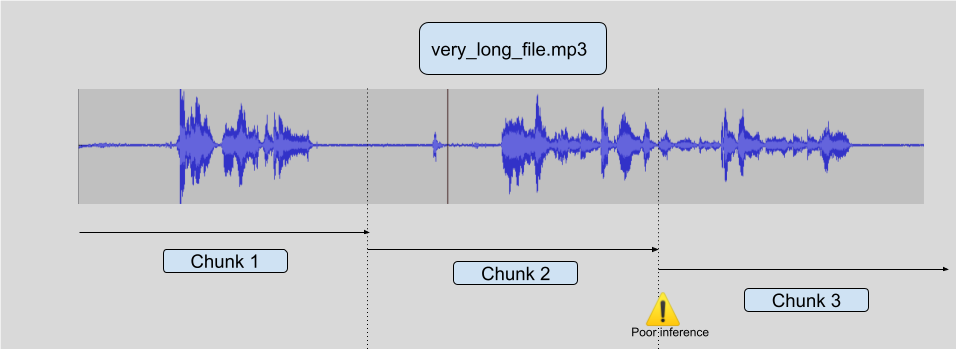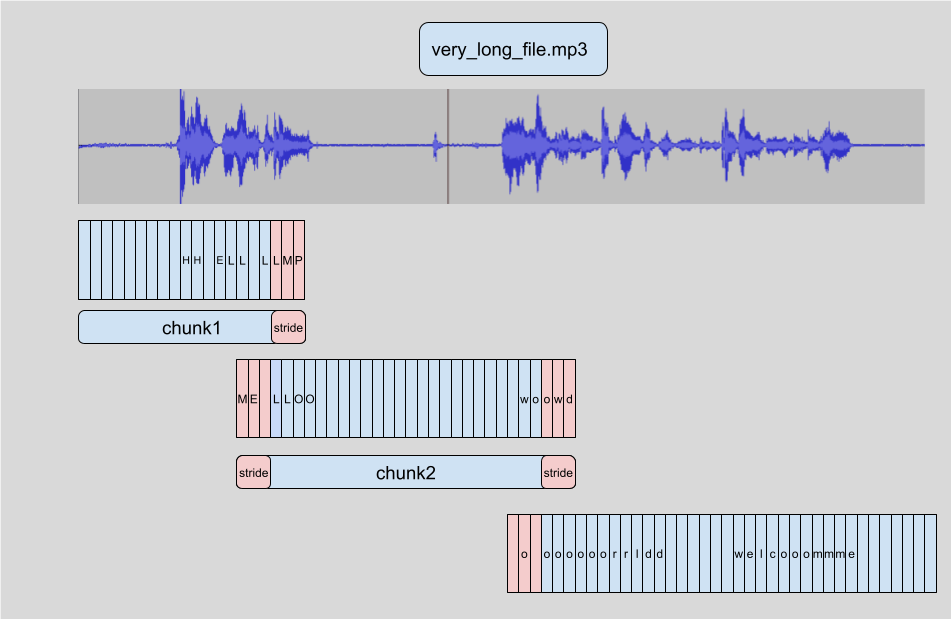Making automatic speech recognition work on large files with Wav2Vec2 in 🤗 Transformers
Tl;dr: This post explains how to use the specificities of the Connectionist
Temporal Classification (CTC) architecture in order to achieve very good
quality automatic speech recognition (ASR) even on arbitrarily long files or
during live inference.
Wav2Vec2 is a popular pre-trained model for speech recognition. Released in September 2020 by Meta AI Research, the novel architecture catalyzed progress in self-supervised pretraining for speech recognition, e.g. G. Ng et al., 2021, Chen et al, 2021, Hsu et al., 2021 and Babu et al., 2021. On the Hugging Face Hub, Wav2Vec2's most popular pre-trained checkpoint currently amounts to over 250,000 monthly downloads.
Wav2Vec2 is at its core a transformers models and one caveat of transformers is that it usually has a finite amount of sequence length it can handle. Either because it uses position encodings (not the case here) or simply because the cost of attention in transformers is actually O(n²) in sequence_length, meaning that using very large sequence_length explodes in complexity/memory. So you cannot run with finite hardware (even a very large GPU like A100), simply run Wav2Vec2 on an hour long file. Your program will crash. Let's try it !
pip install transformers
from transformers import pipeline
# This will work on any of the thousands of models at
# https://huggingface.co/models?pipeline_tag=automatic-speech-recognition
pipe = pipeline(model="facebook/wav2vec2-base-960h")
# The Public Domain LibriVox file used for the test
#!wget https://ia902600.us.archive.org/8/items/thecantervilleghostversion_2_1501_librivox/thecantervilleghostversion2_01_wilde_128kb.mp3 -o very_long_file.mp3
pipe("very_long_file.mp3")
# Crash out of memory !
pipe("very_long_file.mp3", chunk_length_s=10)
# This works and prints a very long string !
# This whole blogpost will explain how to make things work
Simple Chunking
The simplest way to achieve inference on very long files would be to simply chunk the initial audio into shorter samples, let's say 10 seconds each, run inference on those, and end up with a final reconstruction. This is efficient computationally but usually leads to subpar results, the reason being that in order to do good inference, the model needs some context, so around the chunking border, inference tends to be of poor quality.
Look at the following diagram:
There are ways to try and work around the problem in a general fashion, but they are never entirely robust. You can try to chunk only when you encounter silence but you may have a non silent audio for a long time (a song, or noisy café audio). You can also try to cut only when there's no voice but it requires another model and this is not an entirely solved problem. You could also have a continous voice for a very long time.
As it turns out, CTC structure, which is used by Wav2Vec2, can be exploited in order to achieve very robust speech recognition even on very long files without falling into those pitfalls.
Chunking with stride
Wav2Vec2 uses the CTC algorithm, which means that every frame of audio is mapped to a single letter prediction (logit).
That's the main feature we're going to use in order to add a stride.
This link explains it
in the image context, but it's the same concept for audio.
Because of this property, we can:
- Start doing inference on overlapping chunks so that the model actually has proper context in the center.
- Drop the inferenced logits on the side.
- Chain the logits without their dropped sides to recover something extremely close to what the model would have predicted on the full length audio.
This is not technically 100% the same thing as running the model on the whole
file so it is not enabled by default, but as you saw in the earlier example you
need only to add chunk_length_s to your pipeline for it to work.
In practice, we observed that most of the bad inference is kept within the strides, which get dropped before inference, leading to a proper inference of the full text.
Let's note that you can choose every argument of this technique:
from transformers import pipeline
pipe = pipeline(model="facebook/wav2vec2-base-960h")
# stride_length_s is a tuple of the left and right stride length.
# With only 1 number, both sides get the same stride, by default
# the stride_length on one side is 1/6th of the chunk_length_s
output = pipe("very_long_file.mp3", chunk_length_s=10, stride_length_s=(4, 2))
Chunking with stride on LM augmented models
In transformers, we also added support for adding LM to Wav2Vec2 in order to boost the WER performance of the models without even finetuning. See this excellent blogpost explaining how it works.
It turns out, that the LM works directly on the logits themselves, so we can actually apply the exact same technique as before without any modification ! So chunking large files on these LM boosted models still works out of the box.
Live inference
A very nice perk of using a CTC model like Wav2vec2, is that it is a single pass model, so it is very fast. Especially on GPU. We can exploit that in order to do live inference.
The principle is exactly the same as regular striding, but this time we can feed the pipeline data as it is coming in and simply use striding on full chunks of length 10s for instance with 1s striding to get proper context.
That requires running much more inference steps than simple file chunking, but it can make the live experience much better because the model can print things as you are speaking, without having to wait for X seconds before seeing something displayed.




